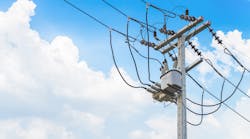The electrical infrastructure needed for a bus charging facility is substantial, and the associated investment is large. Designers must take into consideration factors such as reliability, resiliency, robustness, and redundancy. Ease of installation, placing equipment close to loads, and optimizing the lengths and number of low-voltage raceways must also be addressed to increase the operational efficiency and reduce the up-front capital construction cost of the facility.
The electric power required to charge 40-ft electric buses is in the range of 100kW to 150kW per charging unit. Depending on the arrangement, number of buses to be charged, and the time available for charging, each charging unit can charge two or three buses at one time. For this article, the assumption of charging units to buses is a ratio of 1-to-2. When the number of buses to be charged is in the hundreds — or when the demand exceeds 5MVA — the electrical distribution equipment (including raceways, breakers, and switchgear) increases substantially due to ampacity limitations of the low-voltage overcurrent protective devices (OCPDs). This increase becomes even more pronounced if 100% redundancy in electrical power is required for reliability purposes.
This article reviews the electrical infrastructure design for two models — one medium and one large facility. The medium facility can accommodate between 140 and 160 buses, including any maintenance aisles. The large facility can house up to 240 buses, including any maintenance aisles.
Our initial review is based on a traditional design layout with 100% redundancy. We then review the effectiveness of incorporating an electric utility’s spot network/collector bus design in the system through the operation of transformers connected in parallel. Lastly, we explore the benefits of deploying electrical busways in lieu of raceways/conduits of various sizes to distribute power. We apply this to both the medium and large facilities.
Medium-Size Bus Garage
Given engineering assumptions:
- Average power factor is 90%.
- Medium-size garage houses 140 to 160 buses, including maintenance.
- The ratio of the number of chargers to buses is 1-to-2.
- Each charging unit is rated 150kW, 480V, 3-phase, 200A.
- Electric utility provides service at 13.8kV, 3-phase power and meter is at the same voltage level.
- The customer owns all medium-voltage (MV) and low-voltage (LV) electrical equipment, including transformers and MV switchgear.
- 100% redundancy is required in the electric utility feeder capacity, and this requirement can be satisfied either with two separate electrical feeders originating from two different utility substations or a local standby generator. In our example, we chose to use two separate utility feeders.
- All buses need to be charged concurrently overnight.
- The limitation for the switchgear line-up and the LV main breakers is 6,000A.
Traditional design approach
Given the above assumptions, each MV utility feeder delivers a total electrical demand of 13.4MVA. Following traditional engineering practices, the design offers MV switchgear in a main-tie-main (M-T-M) configuration with four or five MV breakers placed in an outdoor-type metal-clad enclosure. The MV switchgear feeds four 3.75MVA transformers. The transformers are in two 3-hour rated vaults on the roof of the facility (for resiliency and other reasons). This electrical design results in a total of eight 3.75MVA transformers with eight MV feeder breakers (not including spares) on the project.
On the secondary side, the design calls for four 480V, 3-phase switchgear line-ups with 4,000A main breakers in a M-T-M configuration, which are placed in four electrical rooms in the four quadrants on the floor serving the loads. Each switchgear line-up feeds 20 charging units. Eighty 4-in. conduits serve the 4,000A switchgear lineups with appropriately sized conductors. An additional 80 two-inch conduits connect the switchgear lineups to the charging units — again with appropriately sized conductors.
Innovative design approach
Additional assumptions that were made under this approach include:
- The maximum size commercially available copper utility type collector bus is 12,000A; and
- The maximum KAIC rating of any sized collector bus is 200kA.
Compared to the traditional design approach noted above, if the design uses a 10,000A collector bus on the secondary side of multiple transformers of the same size operating in parallel in a spot network fashion with network protectors (NWP), then the number of 3.75MVA transformers and MV feeder breakers can be reduced from eight to six. To determine and verify the available short-circuit current (SCC) values in this configuration, power system design and analysis software was used with a standard impedance factor (5.75%). SCC was found to be 175,335.34A.
In addition to the afore-mentioned equipment reductions, other advantages can be realized by adopting the collector bus concept and operating three transformers in an N-1 electric utility configuration. They include:
- Energy savings due to reduced number transformers operating in parallel.
- If one of the transformers is out of service due to internal faults, the remaining transformers can carry the loads without interruption.
- Collector buses allow multiple taps for loads and enable multiple transformers to operate in parallel while coping with the equipment/device limitations.
- Any one or two transformers can be taken out for maintenance purposes without affecting the redundancy requirement; whereas in a traditional basic design that redundancy is not available.
Reduced equipment needs are also realized on the downstream LV distribution system. Instead of using four 4,000A, 480V, 3-phase switchgear lineups in an M-T-M configuration in four electrical rooms to power a total of 80 charging units, this integrated design uses eight 2,000A busways (four taps on each 10,000A collector bus), each with two cross 1,000A busways in the ceiling that serve five charging units with 200A bus plugs. In addition to avoiding hundreds of conduits/raceways running all over the floor, the following further advantages can be realized by using the busway concept for the LV distribution system:
- The installation costs (i.e., labor required for installing multiple individual conduits) are greatly reduced.
- The space needed for electrical rooms is reduced, as four 4,000A LV switchgear line-ups can be eliminated.
- Flexibility in locating the bus plugs anywhere and adding additional bus plugs if needed.
- Future charging units can be easily accommodated by just replacing the bus plugs with different ampacity plugs versus changing out the conduits, breakers and distribution equipment.
- Busways can be hung from the ceiling, which is typically a dead space, or on the walls and the conduit/feeder drops from the bus plugs are very short.
Large Bus Facility
Given engineering assumptions:
- Average power factor is 90%.
- Large garage houses 240 buses, including maintenance.
- The ratio of the number of chargers to buses is 1-to-2.
- Each charging unit is rated 150kW, 480V, 3-phase, 200A.
- Electric utility provides service at 13.8kV, 3-phase power and meter is at the same voltage.
- The customer owns all MV and LV electrical equipment, including transformers and MV switchgear.
- 100% redundancy is required in the electric utility feeder capacity and this requirement can be satisfied either with two separate electrical feeders originating from two different utility substations or a local standby generator. In our example, we chose to use two separate utility feeders.
- All buses need to be charged concurrently overnight.
- The limitation for the LV switchgear line-up and the LV main breakers is 6,000A.
Traditional design approach
Given the above assumptions, each MV utility feeder delivers a total electrical demand of 20MVA. Following traditional engineering practices, the design offers MV switchgear in a M-T-M configuration with four or five MV breakers in an outdoor type metal-clad enclosure. The MV switchgear feeds four 5MVA transformers. The transformers are in two 3-hour rated vaults on the roof of the facility (for resiliency and other reasons). This electrical design results in a total of eight 5MVA transformers with eight MV feeder breakers (not including spares) on the project.
On the secondary side, the design calls for four 480V, 3-phase switchgear line-ups with 6,000A main breakers in an M-T-M configuration, which are placed in four electrical rooms in the four quadrants on the floor serving the loads. Each switchgear line-up feeds 30 charging units. One-hundred-twenty 4-inch conduits serve the 6,000A switchgear lineups with appropriately sized conductors. An additional 120 2-inch conduits connect the switchgear line-ups to the charging units, again with appropriately sized conductors.
Innovative design approach
Additional assumptions that were made under this approach include:
- The maximum size commercially available copper utility type collector bus is 12,000A; and
- The maximum KAIC rating of any sized collector bus is 200kA.
Compared to the traditional design approach noted previously, if the design uses a 12,000A collector bus on the secondary side of multiple transformers of the same size operating in parallel in a spot network fashion with network protectors (NWP) then the number of 5MVA transformers and MV feeder breakers can be reduced from eight to six. To determine and verify the available short circuit current (SCC) values in this configuration, power system design and analysis software was used with different impedance factors (5.75%, 7%, and 8%). SCCs were found to be:
- With 5.75% impedance factor, the SCC is 215,484.27A.
- With 7% impedance factor, the SCC is 187,495.77A.
- With 8% impedance factor, the SCC is 169,848.02A.
Since the 7% impedance factor transformers have SCCs closer to 200kA, you should use 8% impedance factor transformers in the design. Also, our assumptions about the collector bus ampacity and KAIC were verified to be true.
It should be noted that there’s a marginal cost increase for using 8% impedance transformers compared to the standard 5.75% impedance transformers.
In addition to previously mentioned equipment reductions, other advantages can be realized by adopting the collector bus concept and operating three transformers in an N-1 electric utility configuration: They include:
- Energy savings due to reduced number of transformers operating in parallel.
- If one of the transformers is out of service due to internal faults, the remaining transformers can carry the loads without interruption.
- Collector buses allow multiple taps for loads and enable multiple transformers to operate in parallel while coping with the equipment/device limitations.
- Any one or two transformers can be taken out for maintenance purposes without affecting the redundancy requirement; whereas in a traditional basic design that redundancy will not be available.
As was shown with the medium-sized facility design, reduced equipment needs are also realized on the downstream LV distribution system. Instead of using four 6,000A, 480V, 3-phase switchgear line-ups in M-T-M configuration in four electrical rooms to power a total of 120 charging units, this integrated design uses eight 3,000A busways (four taps on each 12,000A collector bus) each with three cross 1,000A busways in the ceiling that serve five charging units with 200A bus plugs. In addition to avoiding hundreds of conduits/raceways running all over the floor, the following further advantages can be realized by using the busway concept for the LV distribution system:
- The installation costs (i.e., labor required for installing multiple individual conduits) are greatly reduced.
- The space needed for electrical rooms is reduced, as four 6,000A LV switchgear lineups can be eliminated.
- Flexibility in locating the bus plugs anywhere and adding additional bus plugs if needed.
- Future charging units can be easily accommodated by just replacing the bus plugs with different ampacity plugs versus changing the conduits, breakers and distribution equipment.
- Busways can be hung from the ceiling, which is typically a dead space, or on the walls and the conduit/feeder drops from the bus plugs are very short.
Recommendations
Utilization of electric utility type LV collector buses on a commercial design project with a large electrical power demand is highly recommended. On such projects, you should also consider the option of using low-voltage busways, as this could deliver additional equipment and labor savings on the project.
Kuchibhotla is a technical principal and senior supervising electrical engineer for WSP USA in Boston. He can be reached at [email protected]. Trainor is an electrical engineer at WSP. He can be reached at [email protected].



